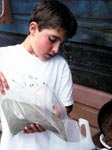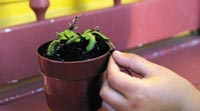In the wild, the Venus flytrap’s habitat is a pine savanna—peaty, sandy soil. This carnivorous plant (CP) is found in North and South Carolina and in a small area of Florida. Venus likes her climate moist and she can even be temporarily covered by water if it floods. She likes it hot, too—fires encourage growth. With this project, you can recreate Venus’s natural habitat, except for the fire.
The materials were a little costly. The Venus flytrap was $7.99. (Please buy a nursery-raised plant from a reputable seller. Digging up wild plants for sale hurts the population and it’s illegal.) The fluorescent light bulb cost $8.98. On the bright side, the bulb will last several years.
Venus Flytrap Materials
Table of Contents
- Scissors
- 4-litre plastic milk jug
- Big plastic Ziploc bag
- Tape
- Sand
- Peat moss (or sphagnum)
- Venus flytrap (or other CP)
- Distilled water (one liter or more)
- Fluorescent light
Instructions
1. First create a terrarium by cutting the milk jug, about ten centimeters down from the top. Cut all the way around to create an opening just big enough to re-pot your CP.

2. Fill the bottom of the jug with sand, about five centimeters high.
3.
Overlay the sand with the peat or sphagnum moss, filling the jug to a little more than halfway.4. Dig a hole about 2.5 centimeters deep. Carefully remove your Venus flytrap from its little pot and place it in the hole. Carefully pat in more moss around the plant’s base.

5. Pour the distilled water all around the moss. The sand and moss need to be moist to create the humidity the CP craves. Tap water can kill it.
 6. Cut open the bottom of the sandwich bag. Fit the bottom of the sandwich bag over the jug’s opening and tape it to the jug. The Ziploc top can be opened and closed for giving your CP some air—or for feeding! (You can use any clear plastic bag if it’s big enough. Just fit the open end over the jug, and tape it down. Cut open the top, and keep it taped shut, or use clips.)
6. Cut open the bottom of the sandwich bag. Fit the bottom of the sandwich bag over the jug’s opening and tape it to the jug. The Ziploc top can be opened and closed for giving your CP some air—or for feeding! (You can use any clear plastic bag if it’s big enough. Just fit the open end over the jug, and tape it down. Cut open the top, and keep it taped shut, or use clips.)
7. Place the plant near a fluorescent light. Venus flytraps need 12 hours of “sun” and a relatively constant temperature. Open the bag every other day to give your CP some fresh air.
 8. Once a week, catch a fly or spider, or some other yummy bug and feed your CP. Just open the plastic bag, put it in. The CP will do the rest! If you’re really keen, catch some food and use tweezers to feed it to your CP. With a Venus flytrap, just place the insect or spider in the “mouth” of one of the leaves—it should snap shut. If you put anything in the “mouth”, it will snap shut, and then open again, but it’s best to avoid stimulating it too often. Each trap will “eat” two or three times before it falls off and a replacement grows.
8. Once a week, catch a fly or spider, or some other yummy bug and feed your CP. Just open the plastic bag, put it in. The CP will do the rest! If you’re really keen, catch some food and use tweezers to feed it to your CP. With a Venus flytrap, just place the insect or spider in the “mouth” of one of the leaves—it should snap shut. If you put anything in the “mouth”, it will snap shut, and then open again, but it’s best to avoid stimulating it too often. Each trap will “eat” two or three times before it falls off and a replacement grows.
Observation
Observation is a big part of science. This is a fun observing project. When CPs were discovered in the 18th-century scientists seriously debated whether they ate bugs! In 1875, Charles Darwin experimented with a sundew plant and proved that they did trap and digest insects. Darwin called the Venus flytrap one of the most wonderful plants in the world.
Apparently, the plant has some other enthusiastic fans who have planted the Venus flytrap in the wild outside of its natural habitat, the bogs of North and South Carolina. How one patch of Venus flytraps ended up in northern Florida remains a mystery. No one has publicly admitted to planting them, but stands are found here and there. It could be that seeds fell from the feet of migratory birds! In any case, the Venus flytraps are healthy and happy in their new home.
A Step Further
- You can use other kinds of CPs. Sometimes pitcher plants are available at nurseries or plant stores. Just ask!
- When the warm weather arrives, you can take your CP outside and see how quickly it catches prey without your help!
- CPs need “meat” to supply the proper nutrients. Is the soil they grow in devoid of nutrients, or do these plants need lots more than the average plant? Trying growing another CP in regular potting soil for houseplants. You can grow a third CP in soil from your backyard and then spray the plant with liquid fertilizer. See what happens!
Further Information
This is a serious book, but if you’re a serious CP grower, you’ll like it. It may even be available at the library. Carnivorous Plants of the United States and Canada, Second Edition, by Donald E. Schnell.

